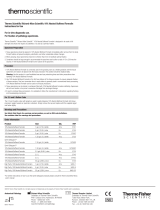
DNA mismatch repair (MMR) is a conserved molecular
mechanism that functions to correct the improper base
substitutions that spontaneously occur during DNA replication.
Polymerase chain reaction (PCR) based methods have shown
that MMR failure frequently leads to microsatellite instability
(MSI), a condition in which short, tandem nucleotide repeats are
inserted into the DNA. When the number of repeats is equal to
or greater than 30% of the examined microsatellite loci, MSI can
be further characterized as MSI-High (MSI-H). Defects in the
MMR machinery have been attributed to mutations in the MMR
proteins, most commonly MLH1, PMS2, MSH2, and MSH6.
The MLH1 and PMS2 proteins normally function together
in a heterodimeric complex, as do the MSH2 and MSH6
proteins. When MMR is functioning normally, the MSH6/MSH2
heterodimer binds to mismatched DNA. This binding induces a
conformational change that allows the MLH1/PMS2 heterodimer
to bind the DNA-bound MSH6/MSH2 complex, resulting in
excision repair of the affected DNA. Mutations or deficiencies
in these proteins result in frequent MSI and somatic mutation due
to replication error. MMR immunohistochemistry (IHC) testing
can be shown to be useful in identifying MMR genes likely to
contain germline or a somatic alterations.
Traditionally, treatment regimens for cancer patients have
been dictated by the specific malignancy. However, emerging
immunotherapies, particularly those that modify cellular
pathways involving the programmed death 1 (PD-1) or
programmed death ligand 1 (PD-L1) proteins, are reshaping
clinicians’ therapeutic strategies. PD-1 is an inhibitory receptor
expressed on T cells after T-cell activation, which is sustained
in states of chronic stimulation such as in chronic infection or
cancer. PD-L1 expression has been observed in immune cells
and malignant cells, and aberrant expression of PD-L1 on tumor
cells (TC) has been reported to impede anti-tumor immunity,
resulting in immune evasion. Therefore, interruption of the PD-
L1/PD-1 pathway represents an attractive strategy to reinvigorate
tumor-specific T cell immunity.
MMR proteins (MLH1, PMS2, MSH2, and MSH6) are ubiquitously
expressed in proliferating normal and malignant cells. Many
common cancers are MMR deficient (dMMR) and exhibit MSI.
Multiple studies have demonstrated that MMR deficiency
correlate with higher expression of PD-1 or PD-L1 proteins.
Thus, MMR proteins may be useful as predictive biomarkers for
PD-1 targeted therapy; specifically, a loss of expression of one
or more MMR proteins might predict an increased likelihood of
response to such therapy. PD-1 inhibitors can be beneficial in
many common cancers with a high frequency of MMR deficiency
and /or MSI-H regardless of the cancers’ tissue of origin.
Hence, patients considering PD-1 targeted therapy will benefit
from a companion diagnostic assay to identify the patient
population with MMR deficiency.
Endometrial carcinoma (EC) is one of the most common
gynecologic malignancies.
12
It is frequently noted to have many
genetic alterations including MSI.
12
It has also been suggested
that MSI EC may have increased PD-L1 protein expression as
compared to the microsatellite stable (MSS) EC.
16
While the
treatment of EC varies depending on the grade, histology and
stage of disease,
17
evaluation of the MMR status of EC tumors is
helpful for prognosis and guiding treatment
12
. Therefore, patients
considering PD-1 targeted therapy will benefit from a companion
diagnostic assay to identify MMR status.
A loss of expression of any of the essential MMR proteins,
including MLH1, PMS2, MSH2, or MSH6, causes MMR
deficiency. Presence of staining for all four MMR protein markers
in the tumor indicates that the case is proficient for VENTANA
MMR IHC status. Absence of staining in any one of the MMR
protein markers of VENTANA MMR RxDx Panel indicates a case
is deficient for VENTANA MMR IHC status.
Introduction
VENTANA MMR RxDx Panel for Endometrial Carcinoma 1

























